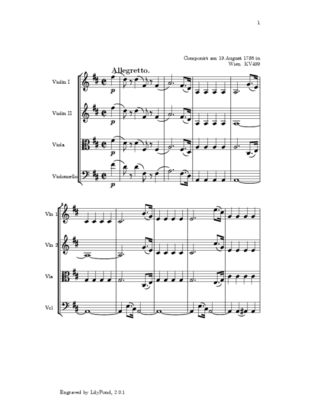
The term string quartet can refer to either a type of musical composition or a group of four people who play them. Many composers from the mid-18th century onwards wrote string quartets. The associated musical ensemble consists of two violinists, a violist, and a cellist.

Chamber music is a form of classical music that is composed for a small group of instruments—traditionally a group that could fit in a palace chamber or a large room. Most broadly, it includes any art music that is performed by a small number of performers, with one performer to a part. However, by convention, it usually does not include solo instrument performances.
The Takács Quartet is a string quartet founded in Budapest, Hungary, and now based in Boulder, Colorado, United States.

The Lindsay String Quartet was a British string quartet from 1965 to 2005.

The String Quartet No. 20 in D major, K. 499, was written in 1786 in Vienna by Wolfgang Amadeus Mozart. It was published by – if not indeed written for – his friend Franz Anton Hoffmeister. Because of this, the quartet has acquired the nickname Hoffmeister. Hoffmeister had started issuing a series of chamber-music publications in 1785, including Mozart's K. 499 as well as Joseph Haydn's Op. 42.
The Amati Quartet was a string quartet, associated with the University of Saskatchewan in Saskatoon, Saskatchewan, Canada. The ensemble performed with four instruments made by the Amati family of luthiers, of Cremona Italy.
The Salomon Quartet was formed in 1982 as one of the first string quartets playing music of the classical period on authentic instruments and informed by historical scholarship. The quartet originally comprised Simon Standage, (violin), Micaela Comberti †, (violin), Trevor Jones †, (viola), and Jennifer Ward Clarke †, (cello). Violin II is now taken by Catherine Martin, viola by Adam Romer and cello by Andrew Skidmore.
G major is a major scale based on G, with the pitches G, A, B, C, D, E, and F♯. Its key signature has one sharp. Its relative minor is E minor and its parallel minor is G minor.
B-flat major is a major scale based on B♭, with pitches B♭, C, D, E♭, F, G, and A. Its key signature has two flats. Its relative minor is G minor and its parallel minor is B-flat minor.
D minor is a minor scale based on D, consisting of the pitches D, E, F, G, A, B♭, and C. Its key signature has one flat. Its relative major is F major and its parallel major is D major.

Erik Eriksson Tulindberg was the first known Finnish composer of classical music.
The Maggini Quartet is a British string quartet. Its members are Julian Leaper, Ciaran McCabe, Martin Outram (Viola) and Will Schofield (Cello).
Karen Tuttle was an American viola teacher, most famous for developing the Karen Tuttle Coordination Technique, which emphasizes being comfortable while playing the instrument. She began performing on violin at the age of sixteen before switching to viola in 1941. Tuttle actively performed and taught at a number of institutions until her retirement in 2005.
The Esterhazy Quartet is an American string quartet founded in 1968 as the ensemble-in-residence of the University of Missouri and is composed of faculty members at the University of Missouri School of Music in Columbia. The Esterhazy Quartet's current members are:
The six String Quartets, Op. 76, by Joseph Haydn were composed in 1797 or 1798 and dedicated to the Hungarian count Joseph Georg von Erdődy (1754–1824). They form the last complete set of string quartets that Haydn composed. At the time of the commission, Haydn was employed at the court of Prince Nicolaus Esterházy II and was composing the oratorio The Creation as well as Princess Maria Hermenegild Esterházy's annual mass.
Homotonal (same-tonality) is a technical musical term that describes the tonal structure of multi-movement compositions. It was introduced into musicology by Hans Keller. According to Keller's definition and usage, a multi-movement composition is 'homotonal' if all of its movements have the same tonic (keynote).
The Tátrai Quartet was a Hungarian classical string quartet founded in 1946. For the half-century after World War II it was one of the foremost string quartets in Hungary, specializing in Haydn and Bartók, whose complete quartets it recorded for Hungaroton, Mozart and Beethoven as well, and were also responsible for first performances of works by certain Hungarian composers.

The six string quartets Op. 20 by Joseph Haydn are among the works that earned Haydn the sobriquet "the father of the string quartet". The quartets are considered a milestone in the history of composition; in them, Haydn develops compositional techniques that were to define the medium for the next 200 years.
Franz Grill was a composer of the Classical Era. He was a composer of piano and chamber music. Little is known of his life, but he died on 18 August 1793 in Ödenburg also known as Sopron, Hungary.





